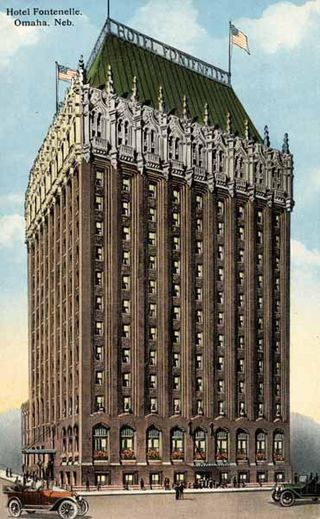
The history of Omaha, Nebraska, began before the settlement of the city, with speculators from neighboring Council Bluffs, Iowa staking land across the Missouri River illegally as early as the 1840s. When it was legal to claim land in Indian Country, William D. Brown was operating the Lone Tree Ferry to bring settlers from Council Bluffs to Omaha. A treaty with the Omaha Tribe allowed the creation of the Nebraska Territory, and Omaha City was founded on July 4, 1854. With early settlement came claim jumpers and squatters, and the formation of a vigilante law group called the Omaha Claim Club, which was one of many claim clubs across the Midwest. During this period many of the city's founding fathers received lots in Scriptown, which was made possible by the actions of the Omaha Claim Club. The club's violent actions were challenged successfully in a case ultimately decided by the U.S. Supreme Court, Baker v. Morton, which led to the end of the organization.
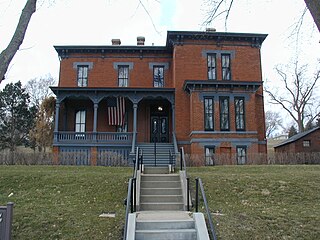
The General George Crook House Museum is located in Fort Omaha. The Fort is located in the Miller Park neighborhood of North Omaha, Nebraska, United States. The house was listed on the National Register of Historic Places in 1969, and is a contributing property to the Fort Omaha Historic District.

The Omaha Quartermaster Depot Historic District, including several brick structures built in Italianate and other styles, was built for the U.S. Army between 1881 and 1894. Located in South Omaha between Hickory and 22nd Streets, Woolworth Avenue and the Union Pacific Railroad main line in Omaha, Nebraska, the depot was listed on the National Register of Historic Places as a historic district in 1979. The depot previously operated as United States Army Reserve facility. The facility is considered surplus by the GSA and was put up for auction in the fall of 2013.

The South Omaha Main Street Historic District is located along South 24th Street between M and O Streets in South Omaha, Nebraska. It was added to the National Register of Historic Places in 1989. Home to dozens of historically important buildings, including the Packer's National Bank Building, the historic district included 129 acres (0.52 km2) and more than 32 buildings when listed.

The Omaha Rail and Commerce Historic District, roughly bounded by Jackson, 15th, and 8th Streets, as well as the Union Pacific main line, is located in downtown Omaha, Nebraska. Today this historic district includes several buildings listed individually on the National Register of Historic Places, including the Union Pacific Depot and the Burlington Station.
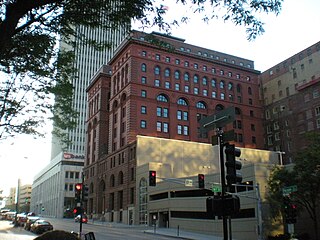
The Omaha National Bank Building was built in 1888–89 at 1650 Farnam Street in Downtown Omaha, Nebraska. Built in the Italian Renaissance style, the building was saved from demolition by a rehabilitation in 1978. Listed on the National Register of Historic Places in 1972, the building was originally known as the New York Life Insurance Building; it was renamed in 1906.
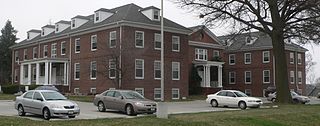
The Old People's Home, presently known as Leo Vaughan Senior Manor, is located at 3325 Fontenelle Boulevard in the Florence neighborhood on the north side of Omaha, Nebraska. Built in 1917, it was listed on the National Register of Historic Places in 1987.

The Christian Specht Building is located at 1110 Douglas Street in downtown Omaha, Nebraska. It is the only existing building with a cast-iron facade known in Nebraska today, and one of the few ever built in the state. The building was deemed an Omaha landmark in 1981, and was listed on the National Register of Historic Places in 1977.

The Melrose Apartments were built in 1916 at 602 North 33rd Street in the Gifford Park neighborhood of Omaha, Nebraska. The Melrose was listed on the National Register of Historic Places in 1989.

Vinton School was built as a fourteen-room elementary school in 1908 at 2120 Deer Park Boulevard in the Deer Park neighborhood of Omaha, Nebraska, United States. Designed by Omaha architect Frederick W. Clarke, Vinton School is the earliest and most elaborate example of a Tudor Revival-style school in Omaha. Designated an Omaha Landmark in June 1990, the building was listed on the National Register of Historic Places in November 1989.

The Flatiron Hotel is located at 1722 St. Mary's Avenue in downtown Omaha, Nebraska. Designed by architect George Prinz and originally constructed in 1912 as an office building, in 1914 it was renovated for use as a hotel. Today the building serves as office and commercial space. It formerly housed an upscale restaurant, the Flatiron Cafe, which closed in 2022. The Flatiron Hotel was added to the National Register of Historic Places in 1987.
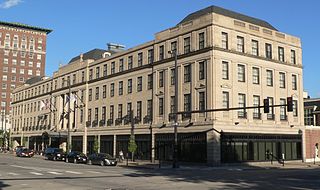
The Magnolia Hotel, formerly the Sheraton Omaha, was originally constructed as the Aquila Court Building, and is located at 1615 Howard Street in downtown Omaha, Nebraska. Built in 1923, it was listed on the National Register of Historic Places in 1974.

The present Douglas County Courthouse is located at 1701 Farnam Street in Omaha, Nebraska, United States. Built in 1912, it was added to the National Register of Historic Places in 1979. Notable events at the courthouse include two lynchings and the city's first sit-in during the Civil Rights Movement. Five years after it was opened, the building was almost destroyed by mob violence in the Omaha Race Riot of 1919.

The Rose Blumkin Performing Arts Center or The Rose, also known as the Astro Theater, originally opened as The Riviera. It is located in downtown Omaha, Nebraska. Built in 1926 in a combination of both Moorish and Classical styles, the building was rehabilitated in 1986.

The Center School, now known as the Lincoln School Apartments, is located at 1730 South 11th Street in South Omaha, Nebraska, United States. Built in 1893, it was declared an Omaha Landmark June 18, 1985 and listed on the National Register of Historic Places on August 23, 1985.
John Latenser Sr. (1858–1936) was an American architect whose influential public works in Omaha, Nebraska, numbered in the dozens. His original name was Johann Laternser.

The Anton Hospe Music Warehouse is a building located at 101 S. 10th Street in Downtown Omaha, Nebraska. It was designed by commercial architect George Fisher and built in 1919 for Anton Hospe, who began business as a picture framer in 1874 and ultimately expanded to a major wholesale and retail dealer in art and musical instruments. The building was operated as the Hospe Music Warehouse until 1936.

The Redick Tower, operated since 2011 as The Hotel Deco, is an eleven-story building located at 1504 Harney Street in Omaha, Nebraska. The building is listed in the National Register of Historic Places.

Hospitals in Omaha, Nebraska have been integral to the city's growth since its founding in 1857. The city has a number of hospitals that were founded by religious groups, and has many medical centers resultant from the mergers of various hospitals. Nebraska is also home to a VA facility that was the only hospital in the United States with a nuclear reactor.
The Ford Warehouse, also known as the Simon Brothers Building, is located at 1024 Dodge Street in Downtown Omaha, Nebraska. It is a six-story brick and stone building constructed in 1919 and was added to the National Register of Historic Places in 1999. It is located near the Omaha Rail and Commerce Historic District and the site of the former Jobbers Canyon Historic District, and is three blocks from the Old Market Historic District. Additionally, the building is also in accordance with the patterns for significance detailed in the Warehouses in Omaha Multiple Property Submission.




















